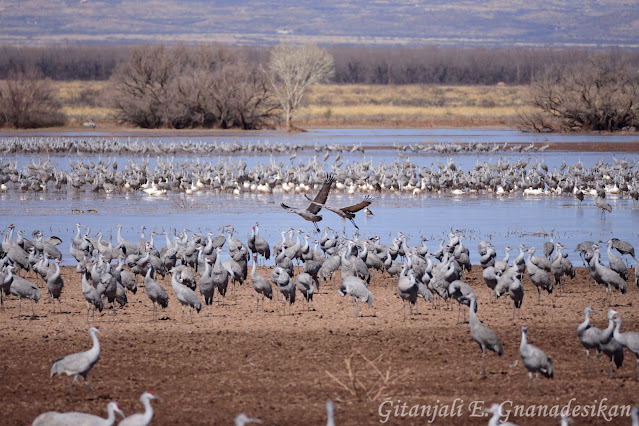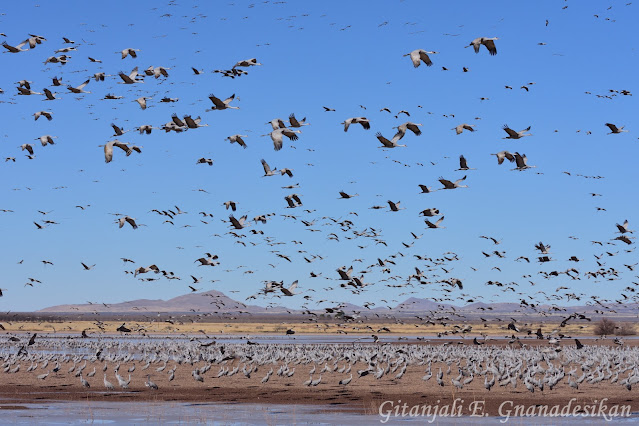A few weeks ago, I drove a couple hours southeast of Tucson to Whitewater Draw to see the sandhill cranes who overwinter here. Apparently about 30,000 cranes overwinter in Arizona, about 2/3 of whom roost at this one site. And it's spectacular.

I'd meant to go for a while, but not managed it, mostly because I'd heard that dawn was the best viewing time (as the cranes wake up and fly off to feed), and it's quite a drive, so I thought I'd do an overnight trip and camp, but then never got around to making it happen. The perils of trying to over-optimize. Ultimately, I was there about 10:30-2:30, which included when many of the cranes flew back for an afternoon nap, and I was perfectly happy with the views and photos.

Here's a close up. All the adults have the red patch on their head. This patch is actually skin, not feathers.

Juveniles, however, do not have the red crown.
Sandhill cranes (Antigone canadensis) are large birds, reaching heights of 1.2 m (47 in)...
With wingspans of 2 m (79 in).
Notice how much larger they are then the snow geese (the white birds with black wingtips)!
The sheer numbers of them are truly amazing, whether they are roosting...
Or flying.
The photos really don't fully convey the experience, but I think a video might help...
Cranes have a tendency to look particularly comical as they come in for landing...
Not only do they reach their legs down, they also seem to stretch out their toes:
I like that in this shot you can also see the ruffling of the wings:
I spent hours watching them, alternating between observing individuals and trying to just take in the scene.
One of the most visually striking behaviors I noticed was the way they drink. They dip their beaks into the water...
And then lift their heads, presumably using gravity to help direct the water down their throats.
Here's a video:
The social behaviors were also very interesting...
Note the open beaks, as they look upward and let out a call.
Interestingly, the individual call sounds rather different than the (beautiful) cacophony of the entire group calling. Here's one:
Sandhill cranes mate for life, which is quite a while given that some individuals in the wild reach 35 years old.
When roosting, I think they look a little bit like gray flamingos (no, they're not particularly closely related), I suppose partly due to the similar strategy of lifting one leg. Ever wonder why some birds do this?
It's to save body heat!
Although the central individual here is a markedly different color, they are not another species, nor is this individual a juvenile (note the red head). Instead, their feathers are simply
stained from rusty muds.
The water was still iced over in parts, which led to some slipping, sliding, and carefully testing the ice at times.
One thing I really enjoyed about watching them for so long was seeing how they'd settle in...
And then for some reason a group would take off, squawking, and sometimes the others would just ignore them, and and sometimes it would lead to a ripple effect of groups taking off, circling for a while, and landing again.
Here's one more (slightly longer) video, if you want to see what I mean. One of the things I found particularly interesting was how even some of the ones who stayed on the ground seemed to move along in the same direction as those flying.
Sandhill cranes spend their summers—breeding season—in Canada, mostly, with some populations in the northern US and Siberia. (Although it's worth noting that there are some more southerly resident populations, including in Cuba and Florida.) The cranes start arriving in Arizona around mid-October and are here through mid-March.

I highly recommend a visit! Many other waterfowl and other birds were also in residence—photos to come soon—but I've probably overwhelmed you just with the crane photos as it is.































































